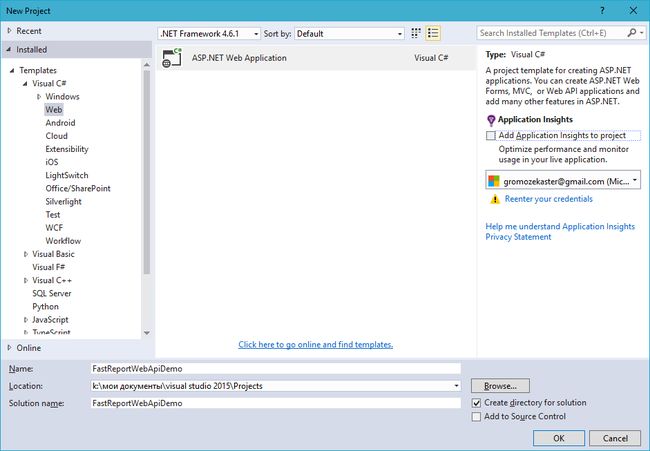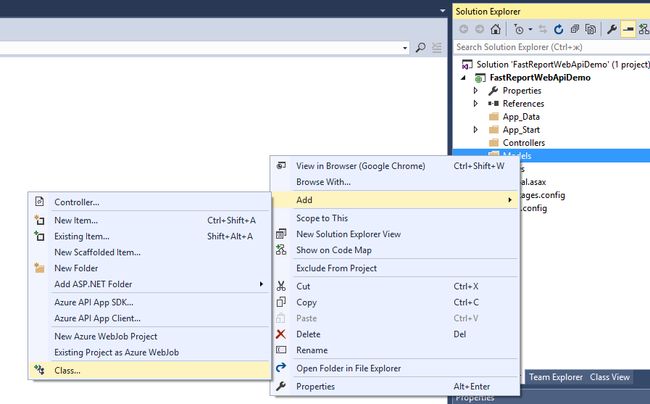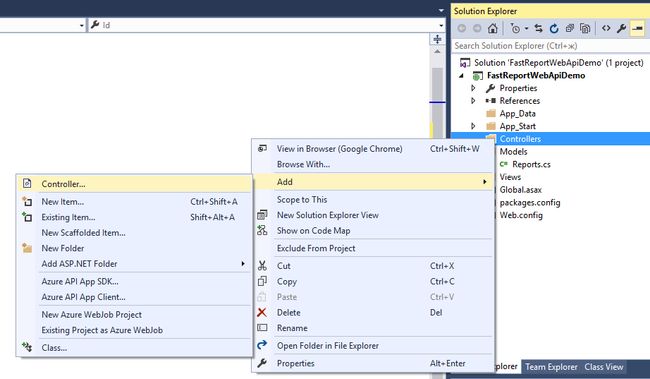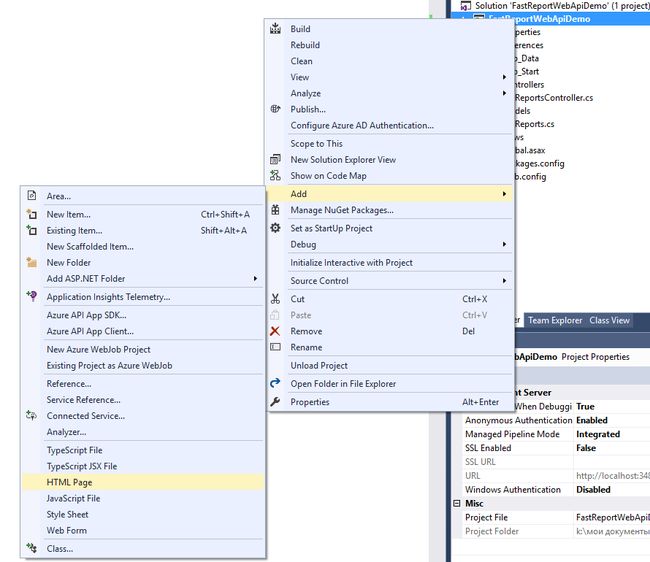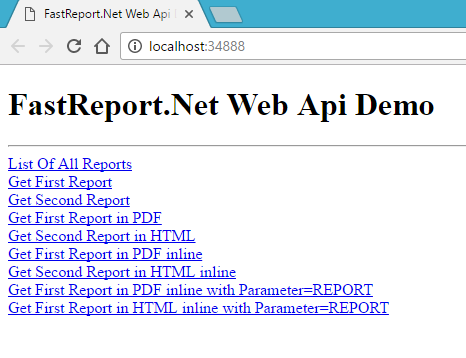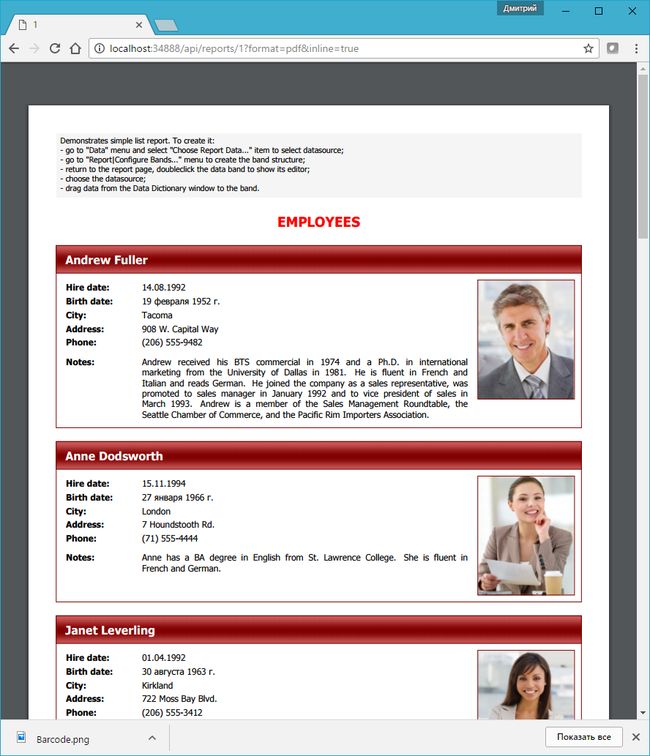如何在ASP.NET Web API中使用FastReport.Net
Web API使你可以快速轻松地创建HTTP服务。与常规的ASP.Net MVC项目不同,Web API不适用于视图。要使用一种特殊类型的控制器,即返回模型对象的方法。
这种控制器的任务是传输数据,而不是表示。我们来看看如何创建一个提供FastReport报表的简单Web服务。
一、首先,我们将创建并显示两个报表。
简单的列表报表模板如下所示:
请注意,报表标题具有[Parameter]参数。你需要添加具有该名称的报表参数。此报表的数据可以从演示数据库nwind.xml的Employee表中获取,具体位置 - C: \ Program Files (x86) \ FastReports \ FastReport.Net \ Demos \ Reports。
第二个报表模板将不包含数据。你可以从文件夹C:\ Program Files(x86)\ FastReports \ FastReport.Net \ Demos \ Reports中获取现成的模板Barcodes.frx。
如上所述,我们将在我们的项目中使用两个报表和一个数据库。将它们添加到文件夹App_Data。在解决方案的浏览器中右键单击该文件夹。选择”添加” - >”现有项目”。像这样,我们添加三个文件:Barcode.frx、Simple List.frx、nwind.xml。或者,你可以简单地用鼠标将这些文件拖动到App_Data文件夹。
二、创建一个ASP.NET应用程序:
单击确定,然后转到项目类型选择:
选择空模板。在底部标记MVC和Web API选项。如果你选择一个Web API模板,你将收到一个充满演示数据的项目。
三、在引用中添加一个链接到FastReport.dll库。
四、现在,你需要添加一个数据模型。
为此,请在解决方案浏览器中选择“模型”文件夹并右键单击。在上下文菜单中,选择Add-> Class:
将该类命名为Reports.cs。默认的类类型是“Class”。点击“添加”。
在创建的类中,使用get和set方法添加两个变量:
namespace FastReportWebApiDemo.Models
{
public class Reports
{
// Report ID
public int Id { get; set; }
// Report File Name
public string ReportName { get; set; }
}
}五、现在将控制器添加到项目中。
在Controllers文件夹上单击右键。从上下文菜单中选择Add-> Controller。
选择控制器模板 - Web API2 Controller - Empty:
命名为ReportsController:
我们继续编码控制器中的逻辑。其任务是在浏览器中提供下载或以其中一种导出格式显示报表:PDF、HTML、png。
using System;
using System.Collections.Generic;
using System.Linq;
using System.Net;
using System.Net.Http;
using System.Web.Http;
using FastReport;
using FastReport.Export.Image;
using FastReport.Export.Html;
using FastReport.Export.Pdf;
using FastReport.Utils;
using FastReportWebApiDemo.Models;
using System.Web.Hosting;
using System.Data;
using System.IO;
using System.Net.Http.Headers;
namespace FastReportWebApiDemo.Controllers
{
// The class of parameters in the query
public class ReportQuery
{
// Format of resulting report: png, pdf, html
public string Format { get; set; }
// Value of "Parameter" variable in report
public string Parameter { get; set; }
// Enable Inline preview in browser (generates "inline" or "attachment")
public bool Inline { get; set; }
}
public class ReportsController : ApiController
{ // Reports list
Reports[] reportItems = new Reports[]
{
new Reports { Id = 1, ReportName = "Simple List.frx" },
new Reports { Id = 2, ReportName = "Barcode.frx" }
};
// Get reports list
public IEnumerable GetAllReports()
{
return reportItems;
}
// Get report on ID from request
public HttpResponseMessage GetReportById(int id, [FromUri] ReportQuery query)
{
// Find report
Reports reportItem = reportItems.FirstOrDefault((p) => p.Id == id);
if (reportItem != null)
{
string reportPath = HostingEnvironment.MapPath("~/App_Data/" + reportItem.ReportName);
string dataPath = HostingEnvironment.MapPath("~/App_Data/nwind-employees.xml");
MemoryStream stream = new MemoryStream();
try
{
using (DataSet dataSet = new DataSet())
{
//Fill data source
dataSet.ReadXml(dataPath);
//Enable web mode
Config.WebMode = true;
using (Report report = new Report())
{
report.Load(reportPath); //Load report
report.RegisterData(dataSet, "NorthWind"); //Register Data in report
if (query.Parameter != null)
{
report.SetParameterValue("Parameter", query.Parameter); // Set the value of the parameter in the report. The value we take from the URL
}
// Two phases of preparation to exclude the display of any dialogs
report.PreparePhase1();
report.PreparePhase2();
if (query.Format == "pdf")
{
//Export in PDF
PDFExport pdf = new PDFExport();
// We use the flow to store the report, so as not to produce files
report.Export(pdf, stream);
}
else if (query.Format == "html")
{
// Export in HTML
HTMLExport html = new HTMLExport();
html.SinglePage = true;
html.Navigator = false;
html.EmbedPictures = true;
report.Export(html, stream);
}
else
{
// Export in picture
ImageExport img = new ImageExport();
img.ImageFormat = ImageExportFormat.Png;
img.SeparateFiles = false;
img.ResolutionX = 96;
img.ResolutionY = 96;
report.Export(img, stream);
query.Format = "png";
}
}
}
// Create result variable
HttpResponseMessage result = new HttpResponseMessage(HttpStatusCode.OK)
{
Content = new ByteArrayContent(stream.ToArray())
};
stream.Dispose();
result.Content.Headers.ContentDisposition =
new System.Net.Http.Headers.ContentDispositionHeaderValue(query.Inline ? "inline" : "attachment")
{
// Specify the file extension depending on the type of export FileName = String.Concat(Path.GetFileNameWithoutExtension(reportPath), ".", query.Format)
};
// Determine the type of content for the browser
result.Content.Headers.ContentType =
new MediaTypeHeaderValue("application/" + query.Format);
return result;
}
// We handle exceptions
catch
{
return new HttpResponseMessage(HttpStatusCode.InternalServerError);
}
}
else
return new HttpResponseMessage(HttpStatusCode.NotFound);
}
}
} 如你所见,我们增加了另一个类到控制器。ReportQuery类定义了HTTP请求参数。这是格式,参数和内联。第一个决定报表导出的格式,第二个决定报表中的参数值,第三个决定报表是否直接在浏览器中打开。
在ReportsController类中,我们创建了一个报表数组和两个方法。名称和报表标识符在数组中定义。第一个方法 GetAllReports () 返回可用报表的列表。在我们的案例中,有两个报表。第二种方法 GetReportById (int id, [FromUri] ReportQuery query) 返回标识符的报表。从查询属性中,我们可以得到参数格式、内联和参数。它们分别定义:报表的导出格式、报表是否会直接在浏览器中打开,要发送到报表的参数的值。
六、在报表中添加一个网页。
有了它,我们将用必要的参数向服务器发送请求。为此,请右键单击项目名称。选择Add-> HTML Page:
设置名称 - Index:
我们将下面的代码添加到页面中:
FastReport.Net Web Api Demo
FastReport.Net Web Api Demo
List Of All Reports
Get First Report
Get Second Report
Get First Report in PDF
Get Second Report in HTML
Get First Report in PDF inline
Get Second Report in HTML inline
Get First Report in PDF inline with Parameter=REPORT
Get First Report in HTML inline with Parameter=REPORT
从标题可以看出,我们可以:
- 获取报表列表;
- 获得第一份报表。根据我们在控制器中的代码,如果我们没有明确地传递格式参数,报表将以png格式显示;
- 接收第二份报表;
- 以PDF格式获取第一份报表;
- 以HTML格式获取第二份报表;
- 以PDF格式获取第一份报表并将其显示在浏览器中;
- 以HTML格式获取第二份报表并将其显示在浏览器中;
- 以PDF格式获取第一份报表并将其显示在浏览器中,并将其转移到报表中;
- 以HTML格式获取第二个报表并将其显示在浏览器中,并将其发送到报表。
七、从文件夹App_Start打开文件WebApiConfig.cs。为Index页面添加一个MapHttpRoute:
public static void Register(HttpConfiguration config)
{
// Web API configuration and services
// Web API routes
config.MapHttpAttributeRoutes();
config.Routes.MapHttpRoute(
name: "Index",
routeTemplate: "{id}.html",
defaults: new { id = "index" }
);
config.Routes.MapHttpRoute(
name: "DefaultApi",
routeTemplate: "api/{controller}/{id}",
defaults: new { id = RouteParameter.Optional }
);
}在同一个文件夹中,找到RouteConfig.cs文件。它可能被删除。
八、最后一步。打开文件Global.asax。删除该行:
RouteConfig.RegisterRoutes(RouteTable.Routes); 现在路由只能通过WebApiConfig来完成。
九、运行应用程序。在浏览器中,我们看到命令列表:
- 第一个链接以XML文档的形式打开报表列表:
- 第二和第三个链接将意味着以png格式下载第一个和第二个报表;
- 第四个链接意味着以PDF格式下载第一个报表;
- 第五个链接意味着以HTML格式下载第二个报表;
- 第六个链接直接在浏览器中打开PDF格式的第一个报表:
- 第七个链接直接在浏览器中以HTML格式打开第二个报表:
- 第八个链接在浏览器中打开PDF格式的第一个报表,并发送REPORT参数:
- 第九个链接在浏览器中以HTML格式打开第一个报表并发送REPORT参数;
以上。在WebAPI中使用FastReport并不比普通的ASP.Net MVC项目更困难。


